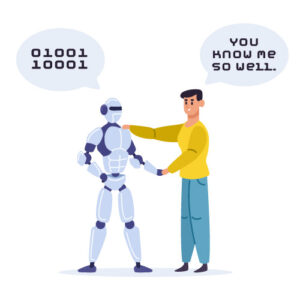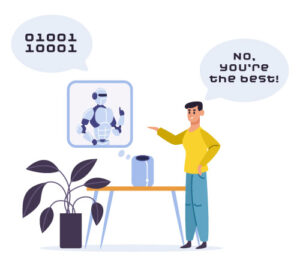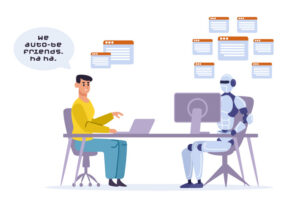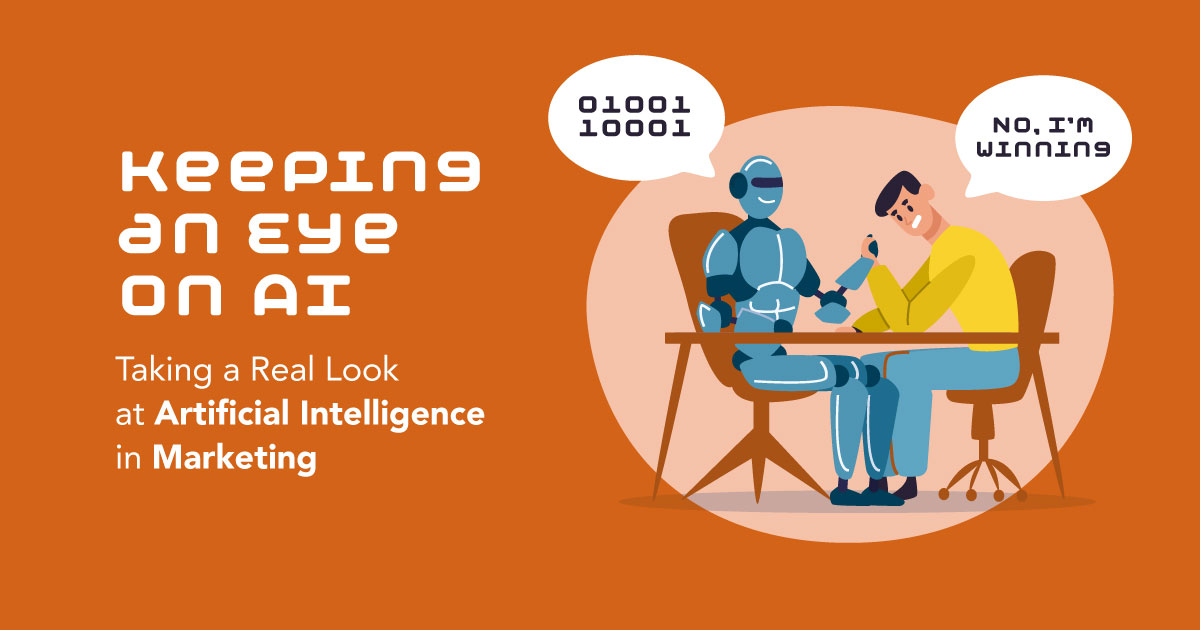Artificial Intelligence (AI) has become an integral part of our lives, changing the way we live, work, and communicate. One of the areas where AI has had a significant impact is in marketing. AI has revolutionized the way companies approach marketing, enabling them to target customers more accurately, personalize their messaging, and automate certain processes. In this article, we’ll explore the impact of AI and how it has transformed the industry.
That’s an introductory paragraph for a blog post about AI and its potential influence on marketing that was authored by—you guessed it—ChatGPT. You might notice that while this intro is accurate, and at least functional, it has (in the opinion of our writing team, anyway) a dry, detached feel that reads more like a legal brief than a piece of content created to captivate an audience and provoke conversation.
A comparison of the first two paragraphs of this very post should illuminate the distinction between content that is adequate and content that is engaging. And that, for us, is worth talking about.

There’s no denying that AI is already revolutionizing how we communicate, and by extension the marketing efforts being built on these new foundations. In the midst of its exploding acceptance, there are evangelists on one side who see it as eclipsing the need for anything other than a supervisory human role, and Luddites on the other who see it as a death knell for the kind of authentic, customized creativity only a professional copywriter, graphic designer, or videographer can deliver. We think the truth is settling somewhere in between these extremes.
A recent infographic created by revenue automation specialist company Nova shares some data on the uptick of AI in marketing that is both exciting and arresting. The use of Generative AI—which takes existing content to create new iterations of text, audio, video, and more—is being explored by more than 77 percent of companies today. Its use has doubled in just five years, finding traction in nearly every sector, including consumer goods, healthcare, financial services, and telecommunications.
Should the surge in AI assimilation be making agency creatives nervous? Perhaps, but the near-term notion is more about acceleration of creative capability and not so much about obsolescence.
A Fast Company article from April of this year offered this reassuring encapsulation:
Generative AI tools are not artists; rather, they are creative factories. This isn’t a story where computers replace our ideas. This is more like the industrial revolution for creativity. With these tools, creative efficiency is set to multiply astronomically.

In short, this technology is not taking over the capabilities of your marketing pros; rather, it will continue to enhance them. More and more marketing experts are respecting this inevitability and are recognizing the exponential influence of AI on content creation and distribution (the pros at Street Level Studio included). They are dedicating bandwidth to understanding its capabilities and how they will supplement (but not supplant) well-engineered outreach efforts across all channels.
Facing and embracing AI in that spirit allows us to weigh its application and present its advantages. Here’s where we see some of its most obvious impact:
Personalization
Marketers can ultra-personalize messaging and hyper-target specific customers with relevant content. It’s possible to analyze customer data, including browsing history, purchase history, and social media activity, to create targeted campaigns that resonate like never before. This is invaluable, especially as consumers demand more personalized experiences, delivery of which means increasing customer engagement and loyalty.

Predictive Analytics
A powerful way to forecast consumer behavior and market trends, predictive analytics uses machine learning algorithms to analyze data and identify patterns and trends that can be used to predict future behavior. This data can anchor more efficient marketing strategies, optimizing campaigns in real-time. Predictive analytics means marketers can make truly data-driven decisions for their clients and keep them ahead of the competition.
Chatbots
It feels a little 2001 A Space Odyssey (“Open the pod-bay doors please, HAL.”) but chatbots use natural language processing to interact with customers in real-time, providing them with personalized assistance and support. They are popping up in every major messaging platform, including Facebook Messenger, WhatsApp, and Slack. This makes it easy for customers to communicate with brands on their preferred channels. Chatbots have also become an essential part of customer service, providing 24/7 support and improving customer satisfaction. That conversation you had with the “customer service rep” on your favorite e-commerce platform the other day? Probably a chatbot.

Image & Voice Recognition
An almost spooky way to create more engaging content, this innovation identifies objects, people, and places in images and makes it possible to create personalized content that better resonates with customers. Similarly, voice recognition is creating interactive and accessible voice experiences, such as voice search and voice-enabled shopping. Both are helping create engaging, immersive—and highly customized—customer experiences.
Automation
Automating certain processes, such as ad targeting, lead scoring, and email marketing, liberates marketing pros and allows them to focus on higher-level tasks. AI painlessly handles repetitive and time-consuming tasks, allowing more budget dedication to strategy and creative development while boosting efficiency and productivity. In a big way, AI is actually able to facilitate more genuine human creativity.
Seeing AI as an innovation that enhances (rather than a disruption that eliminates) the arsenal of influence available to forward-thinking marketing agencies is a first step toward understanding and then optimizing its advantages. Like any technology, it should be seen as a tool best wielded in the hands of a capable craftsperson.

Any company, association, or organization looking to benefit from the boom AI is bringing to outreach and awareness efforts will do well to work with marketing professionals dedicated to balancing the breakthrough advantages of AI with the timeless communications strategies that continue to prove their worth. In this thoughtful synthesis of cutting-edge and classic, there is bound to be success.
If you’re eager to see how the content pros at Street Level Studio can help you envision and execute your future communications strategies, let’s start with an old-fashioned conversation. No chatbots, we promise.
